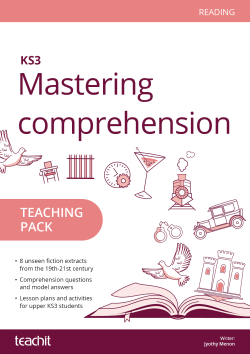Mastering comprehension teaching pack

Designed to develop year 8-9 students' reading comprehension skills and their confidence approaching an unseen fiction text, Mastering comprehension will help upper KS3 students to make the transition to GCSE English Language study.
This teaching pack includes eight literary fiction or prose texts from the 19th-, 20th- and 21st-century. The activities are designed for upper KS3 (years 8-9) or higher attaining KS3 students and should provide a helpful transition to the GCSE/IGCSE assessment focus on unseen literary fiction.
You’ll find extracts from celebrated novels and short stories to appeal to younger students, as well as a range of genres, literary and narrative styles, including first- and third-person narration.
What's included?
The teaching pack is student-facing for use in the classroom, and is designed to provide a series of comprehension practice activities for eight one-hour lessons:
Each lesson includes:
-
a choice of two pre-reading starter activities (focusing on context, prediction, vocabulary development, inference skills, oracy skills etc.)
-
a set of three lesson activities to build students’ reading comprehension skills and strategies, and comprehension and inference questions and tasks:
-
skimming, scanning, selecting, summarising and synthesising information
-
analysing language, literary devices and structure
-
evaluating the text critically
-
writing analytically
-
-
an extension writing task to anticipate some of the fiction and non-fiction writing tasks students will complete in their GCSE English Language exams
-
a plenary or formative assessment activity.
Each activity includes answers, where appropriate and there is also a summative assessment task, which includes exam-style questions, with suggested answers for self or peer marking, or to support teachers.
The resource pack also includes a focus on vocabulary development by building students' confidence approaching unfamiliar or challenging new words.
The lessons can be used in sequence or as one-off English lessons, for cover activities or for independent homework tasks.
The pack includes extracts from Wuthering Heights by Emily Bronte, Brick Lane by Monica Ali, The Trial by Franz Kafka, The Time Machine by H.G. Wells, The Happy-Go-Lucky-Morgans by Edward Thomas, 'The Story-Teller' by Saki, The Great Gatsby by F. Scott Fitzgerald and 'Invisible Mass of the Back Row' by Claudette Williams.
If you are looking for more comprehension activities for younger students, try our KS3 Comprehension teaching pack, or for additional support, try Fix it reading, a complete reading comprehension intervention programme for students aged 11-14.
See all our KS3 teaching packs for more comprehensive schemes of learning to support curriculum planning and delivery.
What's inside?
Introduction (pages 3-7)
Lesson 1: The Happy-Go-Lucky Morgans by Edward Thomas (pages 8-14)
Lesson 2: The Trial by Franz Kafka (pages 15-21)
Lesson 3: ‘The Story-Teller’ by Saki (pages 22-28)
Lesson 4: The Great Gatsby by F. Scott Fitzgerald (pages 29-36)
Lesson 5: ‘Invisible Mass of the Back Row’ by Claudette Williams (pages 37-43)
Lesson 6: The Time Machine by H.G. Wells (pages 44-49)
Lesson 7: Brick Lane by Monica Ali (pages 50-56)
Lesson 8: Wuthering Heights by Emily Brontë (pages 56-62)
Example activities from the teaching pack:
Skim reading
Look again at the text and the words you’ve underlined. Are the meanings of these words clearer now? Can you use any clues from other words in the sentences to help you?
Summarising and creating 'mental movies' of the text
Using this storyboard template, summarise what happens in the story using drawings and words.
Comprehension questions and analysis
1. What does the writer mean by saying ‘the small girls and the small boy emphatically occupied the compartment’?
2. How does the author Saki describe the conversation between the aunt and the children?
3. In the paragraph the writer creates a humorous tone through his use of language and literary techniques. Choose two examples from the extract to show how these techniques create an entertaining tone.
Support:
Here are some examples of techniques the writer uses to help you:
- use of contrast
- use of repetition
- use of expressive adverbs (‘listlessly’, ‘deplorably’) and adjectives (‘petulant’, ‘uninteresting’)
- nouns (girl, aunt, bachelor, story-teller)
Writing activity
Using a train journey as the starting point for a description, piece of travel writing or a short story of your own, write the opening paragraph (250–350 words).
Plenary: Memory game
As a class or in groups, work together to write down all the new words you have learnt from your lesson on the board.
You now have two minutes to remember them all before they will be removed from the board. How many words can you remember?
